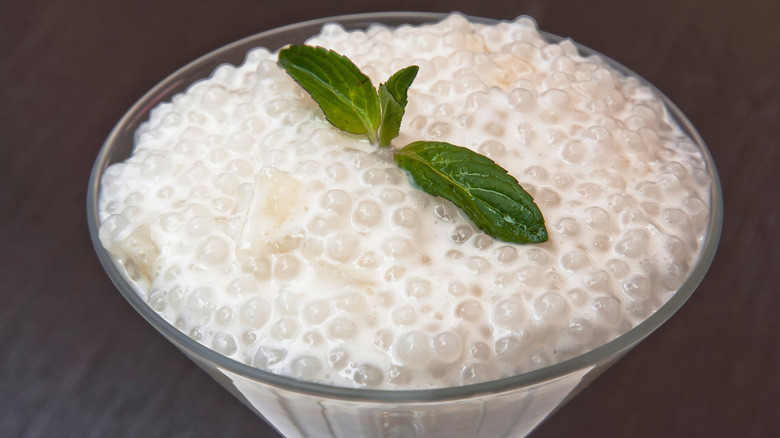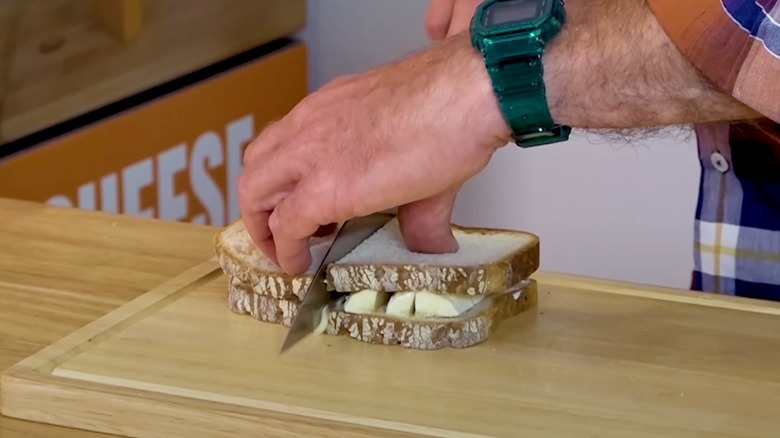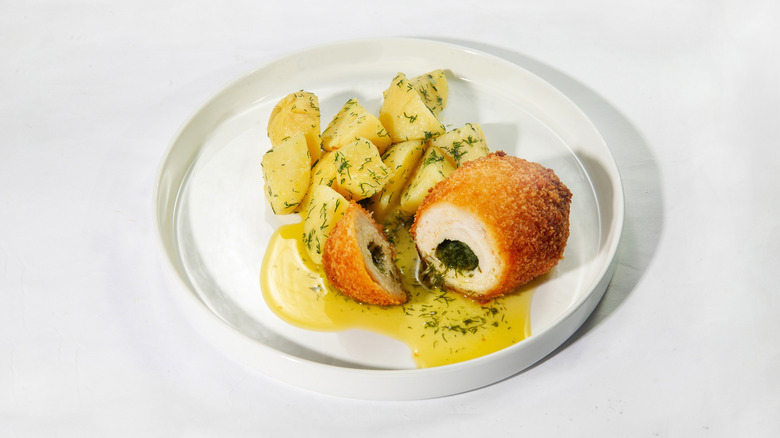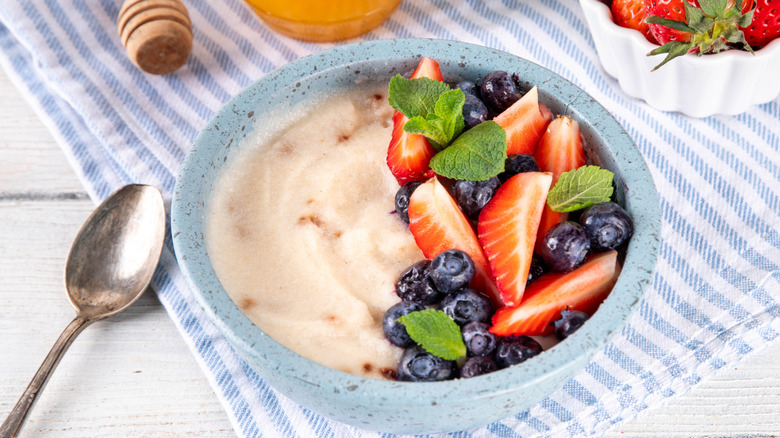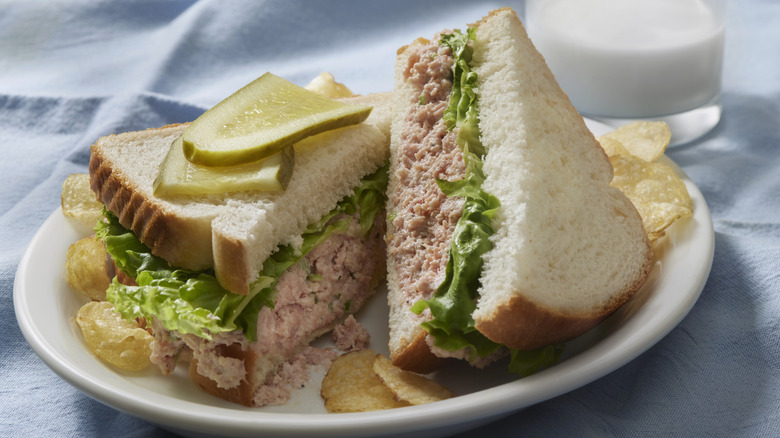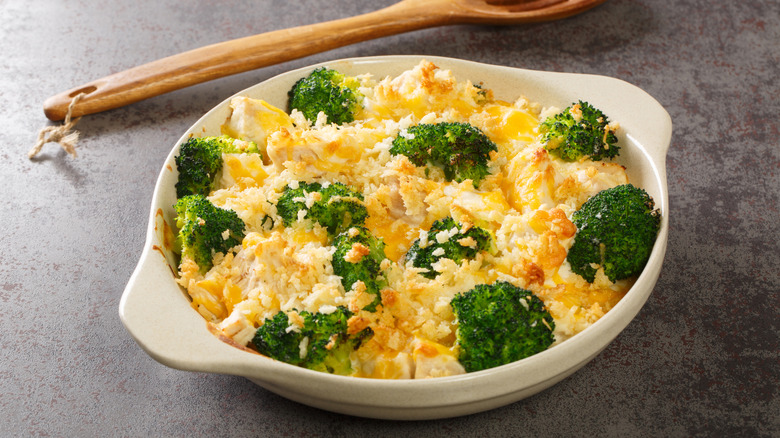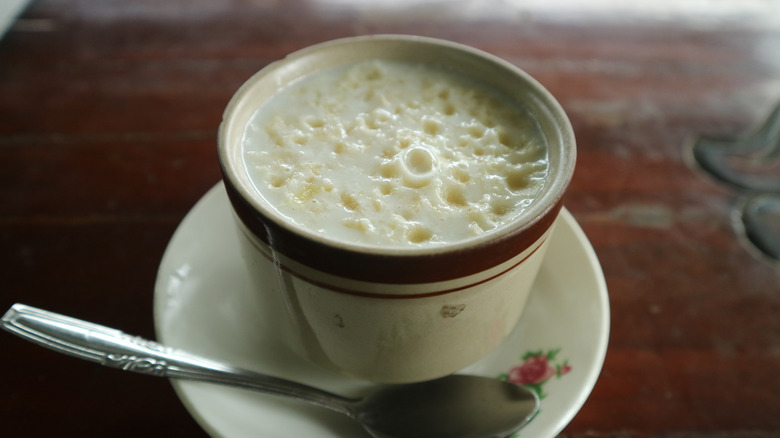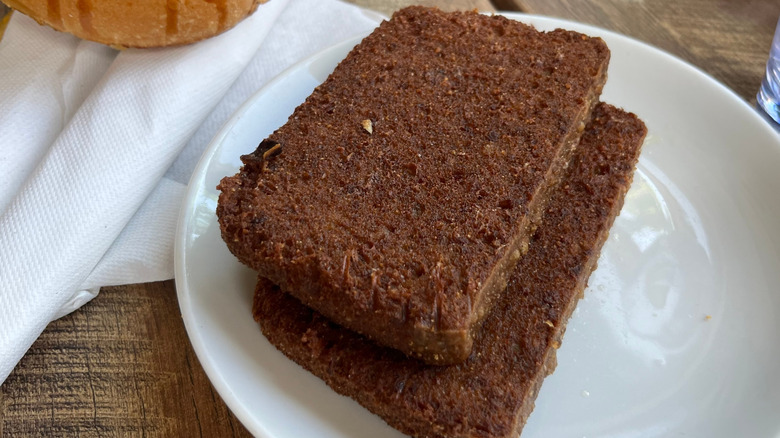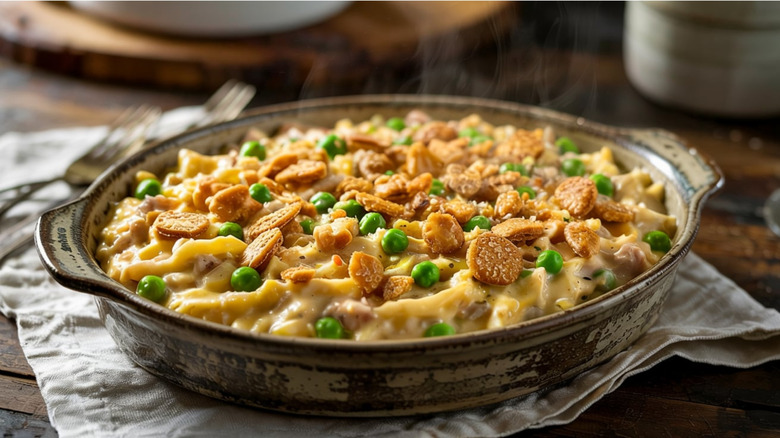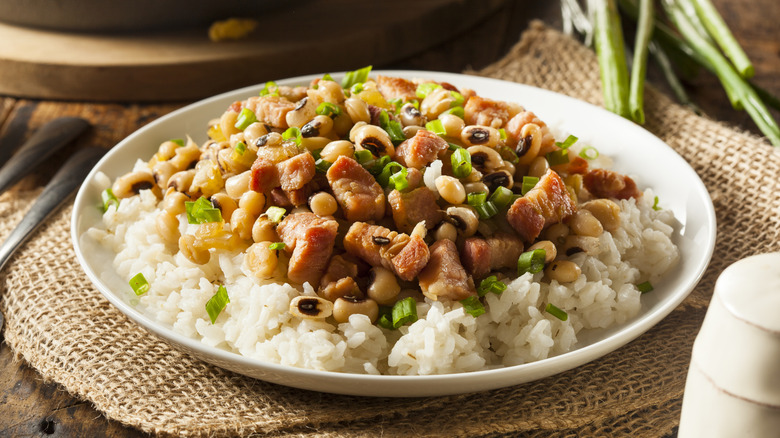Comfort Foods That Used To Be Everywhere (But You Rarely See Now)
What's your comfort food? It may well have changed over time. Comfort foods unlock a sense of safety in us, and eating them can create a cozy feeling of nostalgia and warmth, which puts us right back in our childhoods. They do this by altering our brain chemistry, releasing dopamine, which relaxes us and reduces stressful or painful emotions. However, the foods that do this can vary significantly from person to person and from generation to the next. What might be comfort food to your grandparents might cause you to raise your eyebrows, but there's no denying their potency to those who came before us.
Sadly, though, many of these comfort foods have now become retro, dated meals that we probably wouldn't eat ourselves. In some cases, that's understandable: scrapple, banana and mayo sandwiches, and carrot pudding aren't exactly high on our list of foods to try. Elsewhere, though, we think that now-rare comfort foods like chicken divan and chicken kyiv deserve a big old comeback. We're digging into those cozy foods of yore to see what made the generations above us feel warm and fuzzy.
Banana and mayo sandwiches
Comfort foods are individual things — and while we find it a little tricky to understand exactly why some folks are drawn to banana and mayo sandwiches as a source of security, we can also respect that people really crave this unexpected sandwich filling. Banana and mayo sandwiches seem to have started during the Great Depression, a time when food insecurity was widespread and people had to get pretty resourceful with how they fed themselves. Luxuries like chocolate and sweets were out of the question, so comfort came in the form of cheap and easily available foods like bananas, mayo, and bread.
The combo was popular, but by the middle of the 20th century, people started to find joy in foods that were once again obtainable. As a result, banana and mayo sandwiches died out. While we're not going to be snacking on these sandwiches any time soon, we can somewhat get how this flavor combo might have worked, with the tanginess of the mayo helping to create a sweet-sour effect with the banana. However, we personally think there are other ways to enjoy this dynamic that aren't so odd.
Chicken Kiev
If you've never tried Chicken Kiev, we implore you to seek it out. This all-time comfort food is incredibly retro nowadays, but that doesn't mean it isn't still super tasty. Chicken Kiev was adapted from a veal-based dish created by chefs in Paris and brought to Russia in the 1840s, where it was made using poultry. The dish took off in Moscow and subsequently became a staple of Russian and Ukrainian restaurants in post-World War II America. Eventually, the shine wore off the dish, which started to feel distinctly '70s, and it became tough to find everywhere except the most well-stocked freezer sections in supermarkets.
We think that's a huge shame. Chicken Kiev balances the delicate flavors of chicken with the bold, punchy ones of a garlic and herb-infused butter, which is placed in the center of the meat. This roulade-like parcel is covered with breadcrumbs and then fried until golden. It can be served with anything: fries, mashed potatoes, rice, or even buttered noodles. Once you try it, you won't want to eat anything else for dinner.
Cream of wheat
You've probably tried oatmeal, you may well have had congee, and we're willing to bet you've munched on grits — but have you had cream of wheat? If you haven't, you're missing out on a bygone American staple that we think gets a bad rep. Cream of wheat may now be something that we associate with older adults, but back in the day, it was a highly popular breakfast cereal. The dish was first created and sold for mass consumption in 1893 and quickly took off. While the owners of the Cream of Wheat brand name may have changed several times over its 130-year history, it's still a product that you can find in stores today (although you'll probably have to look fairly hard to do so, and likely on a shelf that few people stop at).
The comforting appeal of cream of wheat is pretty clear, and lives strong in the dwindling number of people who are still fans of this breakfast dish. Like all of the other porridges mentioned above, morning cream of wheat has a warming, smooth consistency that hits the spot on a cold day. It's also adaptable and takes on savory and sweet flavors well. It's hardly trendy these days, but it's still worth trying once in your life.
Deviled ham sandwiches
There once was a time when America was obsessed with turning virtually any protein into a creamy form. One of the most questionable instances of this was the creation of deviled ham. This ham spread is a total comfort food to some who associate it with their childhoods, and who used to pile this ham spread into white bread sandwiches. Never mind the slightly dog food-like smell: For a small subsection of folks out there, this combo was heaven.
Deviled ham would often come in canned form, or people would make it at home. To do so, all it took was to finely mince ham and mix it with mayo, mustard, your choice of flavor elements like hot sauce or Worcestershire, and a little vinegar. Doing this didn't lose the ham's texture, but changed it into a different, more pulverized form. Deviled ham sandwiches feel like one of those dishes that were mainly left behind in the '70s, when the craze for making mousses and spreads of other foods was at its peak. To be honest, we can't say we're sad about that.
Chicken Divan
The 20th century is littered with comforting chicken dishes that now feel a little unstylish. Of all of these, Chicken Divan has to be one of our favorites. This old-school comfort dish is said to have been invented in the Divan Parisien, a restaurant in the now-closed Chatham Hotel in New York City. First appearing in the '30s or '40s, Chicken Divan was soon found in both fancy dining halls and home kitchens alike. The '50s saw the dish explode in popularity.
In our opinion, it's the combination of heartiness, cost-effectiveness, and a soothing nature that makes Chicken Divan so appealing. One of the first chicken casseroles, its incorporation of broccoli spawned a million imitators. Its adaptability meant that home cooks could jazz it up in different ways, including adding breadcrumbs or graham crackers to create a crunchy topping or mixing in herbs and spices. By the '60s, Chicken Divan's popularity dipped, and it started to disappear from restaurants. It now exists as a niche dish made by people in the know, and there aren't many of them left.
Tapioca pudding
Desserts don't get more retro than tapioca pudding. An enormously comforting bowl of creamy goodness and sumptuous vanilla flavors and scents, tapioca pudding is the bubblier, less-fashionable cousin of rice pudding. Both desserts combine a starchy element with milk, sugar, vanilla, and sometimes cream, simmering everything together until you get a thick, bumpy consistency. The tapioca, which is made from cassava root, releases its starches into the liquid to plump everything up.
Tapioca pudding's rise in the United States can be attributed to Susan Stavers, a housewife who created quick-cook tapioca in the late 19th century, the rights of which were eventually sold to John Whitman. Whitman started a factory operation to produce the tapioca on a mass scale, and its quick-cook nature took off. The dish subsequently became a staple of school lunches. However, after a good run, tapioca pudding was replaced on dessert menus by trendier, more elaborate dishes. Serving it became a bit of a running joke, and its appeal gradually waned. Although rice pudding endured, tapioca pudding is now a rarity. Tapioca itself, though, isn't: In recent years, the unstoppable rise of boba tea has made it a must-have item once more.
Scrapple
If you've ever had scrapple, you probably haven't forgotten about it. Scrapple can be considered the original mystery meat, and its roots go all the way back to the 1600s. A combination of ground-up pork offcuts, offal, and starch, scrapple was first pioneered by German-speaking settlers who subsequently became the Pennsylvania Dutch community, whose workers needed something protein-rich, cheap, and comforting to fuel long days grafting in the fields. Scrapple remained a local, homemade dish until the 1800s, when it developed a more widespread appeal, but it never gained nationwide appeal.
That might be because of its ingredients, which tend to take a "waste not, want not" approach. Traditional scrapple is made from any pork products that you wouldn't cook on their own, like tongue, liver, and even skin. This naturally makes it unpalatable for folks who prefer cuts of meat they'd normally otherwise eat. In addition, scrapple was never industrialized in the way that items like Spam were. When canned meat started dominating the market, this dish didn't stand a chance. Scrapple can still be found across Pennsylvania, particularly in local communities. It's not a widespread dish by any means, though.
Tuna noodle casserole
If you want to feel like you've taken a time machine back to the 1950s, tuna noodle casserole is the dish for you. This casserole is synonymous with mid-century cooking, particularly in Midwestern America, where it became a home-cooked favorite for those needing a cheap and easy meal. Although it first appeared a couple of decades before, it wasn't until the '50s that it really hit its stride. This makes sense, given that the decade was defined by home cooking and the increased use of processed and convenience foods and dishes that were economical and easy to prepare.
All of these hallmarks exist in tuna noodle casserole. The big draw for folks making the dish was the inclusion of cream of mushroom soup, which cut out the laborious step of making a white sauce from scratch. All you really had to do to make it was open some cans of tuna, soup, and peas, combine them with noodles, top everything with cheese, and put it in the oven. We'd imagine tuna noodle casserole gave many first-time cooks a lot of confidence, given how easy it was to prepare. However, by the time the '50s were up, tuna noodle casserole was already feeling passé. It didn't entirely disappear, but it's taken on a very vintage feel, and it's rare to serve it to guests nowadays.
Hoppin' John
Some dishes begin to lose their popularity because they seem old-fashioned; while others lose it because they becomes harder to taste like the recipe of the past. The latter is the case with Hoppin' John, a "Carolina pilau" which is seen as one of the most iconic rice and bean dishes of the antebellum South. Hoppin' John was first cooked by West Africans brought to the United States by the slave trade, who were specifically sought out for their knowledge of rice cultivation, one of the crops that Southern plantation owners grew. The West African natives would cook rice with red peas to create dishes that were reminiscent of their native homes, leading to the birth of this dish.
For many years, Hoppin' John was a comforting staple, and it remains a traditional New Year's dish in Southern households. Over time, the rise of processed and canned foods put this dish on the back burner. Hoppin' John's appeal lies in its lengthy preparation and traditional ingredients. Over the years, recipe authors have cut corners and offered easier versions, leading to a diluted version of the dish. This has left many people wondering why it was so popular in the first place. If you want to see why, try making a traditional Hoppin' John using red peas, Carolina Gold rice, and punchy smoked bacon.
Carrot pudding
Before carrot cake, there was carrot pudding. This 17th-century comfort food was the precursor to the popular baked dish we all know and love today, and what might surprise you is how long it stuck around. Carrot pudding was first cooked in medieval England (although it may well have reached the island from the Middle East), and various recipes for it were published in cookbooks up until the 19th century. It appears that carrot cake began to take over at that point, with recipes calling for baking instead of steaming and incorporating more sugar and flour to increase its tenderness.
If you've ever tried carrot pudding, you'll know the difference between it and carrot cake. Carrot pudding tends to be denser and has a much more vibrant appearance, with the orange of the carrots shining through in full force. Carrot cake, on the other hand, tends to use carrots more minimally and ladles on the frosting. We'd be amazed if you found carrot pudding anywhere today, but the good news is it's pretty easy to make at home, so give it a whirl.
